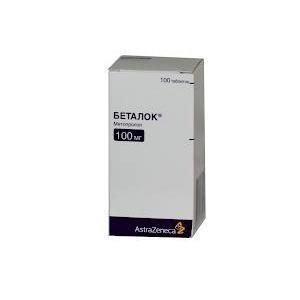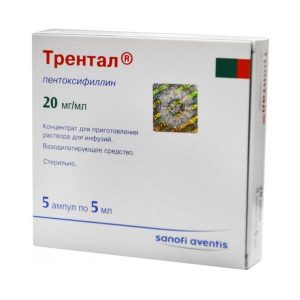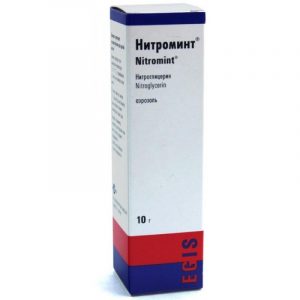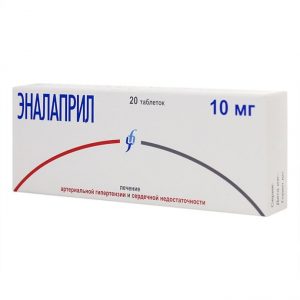Description
Latin name
Betaloc
Release form
Tablets.
Packing
100 pcs. 100 mg each.
Pharmacological action
Metoprolol is a 1-blocker that blocks 1 receptors at doses much lower than the doses required to block 2 receptors. Metoprolol has a slight membrane-stabilizing effect and does not show the activity of a partial agonist. Metoprolol reduces or inhibits the agonistic effect that catecholamines, released during nervous and physical stresses, exert on the cardiac activity. This means that metoprolol has the ability to prevent an increase in heart rate, minute volume and increased contractility of the heart, as well as an increase in blood pressure caused by a sharp release of catecholamines.
Patients with symptoms of obstructive pulmonary disease may be prescribed metoprolol in combination with 2-adrenergic agonists if necessary.
When used in conjunction with Betaloc ® 2-adrenergic agonists in therapeutic doses, it is less likely to affect bronchodilation caused by 2-adrenergic agonists than non-selective -adrenergic blockers. Metoprolol to a lesser extent than non-selective -Adrenoblockers affects insulin production and carbohydrate metabolism. The effect of Betaloc ® on the reaction of the cardiovascular system under conditions of hypoglycemia is significantly less pronounced compared to non-selective p-blockers.
Clinical studies have shown that Betalok ® can cause a slight increase in triglycerides and a decrease in the content of free fatty acids in the blood. In some cases, there was a slight decrease in the fraction of high density lipoproteins (HDL), which is less pronounced than in the case of non-selective P-blockers. However, in one clinical study, a significant decrease in the level of total serum cholesterol was shown during treatment with metoprolol for several years.
The quality of life during the treatment with Betalok ® does not deteriorate or improve. Improving the quality of life during treatment with Betaloc ® was observed in patients after myocardial infarction.
Indications
Arterial hypertension: lowering blood pressure and lowering the risk of cardiovascular and coronary death (including sudden death).
Angina pectoris.
Heart rhythm disturbances, including supraventricular tachycardia.
In complex therapy after myocardial infarction.
Functional disorders of the heart, accompanied by tachycardia.
Prevention of migraine attacks.
Hyperthyroidism (combination therapy).
Contraindications
Atrioventricular block II and III degree.
Decompensated heart failure.
Patients receiving long-term or intermittent therapy with inotropic drugs and acting on beta-adrenergic receptors.
Clinically significant sinus bradycardia.
Sick sinus syndrome.
Cardiogenic shock.
Severe peripheral circulatory disorders.
Arterial hypotension.
Betalok is contraindicated in patients with acute myocardial infarction with a heart rate of less than 45 beats per minute, a PQ interval of more than 0.24 seconds or a systolic blood pressure of less than 100 mmHg.
For serious peripheral vascular disease with the threat of gangrene.
Patients receiving -adrenoblockers, intravenous administration of blockers of “slow” calcium channels such as verapamil is contraindicated.
Age under 18 years (efficacy and safety not established).
Known hypersensitivity to metoprolol and its components or to other -adrenergic blockers.
Precautions: atrioventricular block I degree, Prinzmetal angina, chronic obstructive pulmonary disease (emphysema, chronic obstructive bronchitis, bronchial asthma), diabetes mellitus, severe renal failure.
Use during pregnancy and lactation
Like most Betalok ® preparations, it should not be prescribed during pregnancy and during lactation, unless the expected benefit to the mother outweighs the potential risk to the fetus and / or baby. Like other antihypertensive drugs, -blockers can cause side effects, such as bradycardia in the fetus, newborns or breast-fed babies.
The amount of metoprolol that is excreted in breast milk, and – the blocking effect in a breast-fed baby (when the mother is taking metoprolol in therapeutic doses), are negligible.
Composition
1 tablet contains:
Active ingredient:
metoprolol tartrate 100 mg.
Excipients:
lactose monohydrate,
magnesium stearate,
microcrystalline cellulose,
sodium carboxymethyl starch,
silicon dioxide anhydrous,
povidone.
Dosage and administration
Tablets can be taken with food or on an empty stomach.
Arterial hypertension
100-200 mg Betalok ® once in the morning or in two doses in the morning and evening. If necessary, the dose can be increased or another antihypertensive agent added.
Long-term antihypertensive therapy with 100-200 mg Betalok per day reduces overall mortality, including sudden death, as well as the incidence of cerebral strokes and coronary circulation disorders in patients with arterial hypertension.
Angina pectoris
100-200 mg per day in two divided doses in the morning and evening. If necessary, another antianginal drug may be added to therapy.
Heart rhythm disturbances
100-200 mg per day in two divided doses in the morning and evening. If necessary, another antiarrhythmic drug may be added to therapy.
Maintenance therapy after myocardial infarction
The maintenance dose is 200 mg per day in two divided doses in the morning and evening. The appointment of Betaloc at a dose of 200 mg per day allows to reduce mortality in patients after myocardial infarction, and to reduce the risk of developing myocardial infarction (including in patients with diabetes mellitus).
Functional disturbances in cardiac activity, accompanied by tachycardia
100 mg Betalok once a day, it is recommended to take a pill in the morning. If necessary, the dose may be increased.
Prevention of migraine attacks
100-200 mg per day in two divided doses in the morning and evening.
Hyperthyroidism
150-200 mg per day in 3-4 doses.
Impaired renal function
There is no need to adjust the dose in patients with impaired renal function.
Impaired liver function
Typically, dose adjustment of metoprolol is not required due to the low degree of plasma protein binding. However, in severely impaired liver function (in patients with severe liver cirrhosis or portocaval anastomosis), a dose reduction may be required.
Elderly
There is no need to adjust the dose in elderly patients.
Children
Experience with Betaloc ® in children is limited.
Side effects
Betal is well tolerated by patients and the side effects are mostly mild and reversible.
As a result of clinical trials or with the use of Betalok (metoprolol tartrate), the following undesirable side effects have been described in clinical practice. In many cases, a causal relationship with Betalok treatment has not been established.
The following criteria were used to assess the incidence of cases:
Very often (> 10%).
Often (1-9.9%).
Infrequently (0.1-0.9%).
Rarely (0.01-0.09%).
Very rare (<0.01%). Cardiovascular system: often – bradycardia, postural disorders (very rarely accompanied by fainting), cold extremities, palpitations infrequently – temporary worsening of heart failure symptoms, cardiogenic shock in patients with acute myocardial infarction AV block I degree rarely – other cardiac conduction disturbances, arrhythmias are very rare – gangrene in patients with previous severe peripheral circulatory disorders. CNS: very often – increased fatigue often – dizziness, headache rarely – increased nervous irritability, anxiety, impotence / sexual dysfunction infrequently – paresthesia, convulsions, depression, loss of attention, drowsiness or insomnia, nightmares very rarely – amnesia / memory impairment, depression, hallucinations. GIT: often – nausea, abdominal pain, diarrhea, constipation infrequently – vomiting rarely – dry mouth. Liver: rarely – impaired liver function. Skin: infrequently – rash (in the form of urticaria), excessive sweating rarely – hair loss is very rare – photosensitivity, exacerbation of psoriasis. Respiratory: often – shortness of breath with physical effort infrequently – bronchospasm in patients with bronchial asthma rarely – rhinitis. Sensory organs: rarely – visual impairment, dryness and / or eye irritation, conjunctivitis very rarely – tinnitus, taste disturbances. Metabolism: infrequently – weight gain. From the side of the musculoskeletal system: very rarely – arthralgia. Blood: very rarely – thrombocytopenia. Drug Interaction Co-administration of Betalok ® with the following drugs should be avoided: bardlkp Barbituric acid derivatives: barbiturates (the study was conducted with phenofarbital) slightly increase the metabolism of metoprolol due to the induction of enzymes. Propafenone: In the administration of propafenone to four patients receiving metoprolol treatment, there was a 2-5 fold increase in plasma metoprolol concentration, with two patients experiencing side effects characteristic of metoprolol. This interaction was confirmed in a study of 8 volunteers. The interaction is likely due to the inhibition of propophenone, like quinidine, by metoprolol metabolism via the cytochrome P4502D6 system. Given the fact that propafenone has the properties of a -Adrenoblocker, the co-administration of metoprolol and propafenone does not appear to be appropriate. Verapamil: A combination of blockers (atenolol, propranolol and pindolol) and verapamil can cause bradycardia and lead to a decrease in blood pressure. Verapamil and β-adrenoblockers have complementary inhibitory effects on atrio-ventricular conduction and sinus node function. Combination of Betalok ® with the following drugs may require dose adjustments: Class I antiarrhythmic agents: Class I antiarrhythmic agents and blockers can lead to the summation of a negative inotropic effect, which can lead to a severe hematitis . Such a combination should also be avoided in patients with sinus node weakness and AV conduction disorders. The interaction is described by the example of disopyramide. Amiodarone: Co-administration of amiodarone and metoprolol may lead to marked sinus bradycardia. Taking into account the extremely long half-life of amiodarone (50 days), the possible interaction after a long time after withdrawal of amiodarone should be considered. Diltiazem: Diltiazem and -adrenoblockers mutually enhance the inhibitory effect on AV conduction and sinus node function. In combination with metoprolol with diltiazem, cases of marked bradycardia were noted. Nonsteroidal anti-inflammatory drugs (NSAIDs): NSAIDs weaken the antihypertensive effect of blockers. This interaction is most documented for indomethacin. The described interaction for sulindac was not noted. In studies with diclofenac, no response was reported. Diphenhydramine: Diphenhydramine reduces the clearance of metoprolol to -hydroxymetoprolol by 2.5-fold. At the same time, there is an increase in the effect of metoprolol. Epinephrine (adrenaline): 10 cases of severe hypertension and bradycardia have been reported in patients receiving nonselective β-blockers (including pindolol and propranolol) and receiving epinephrine (adrenaline). The interaction was also noted in the group of healthy volunteers. It is assumed that such reactions can be observed when using epinephrine in conjunction with local anesthetics in case of accidental entry into the vascular bed. This risk is assumed to be much lower when using cardioselective Blockers. Phenylpropanolamine: Phenylpropanolamine (norephedrine) at a single dose of 50 mg may increase diastolic blood pressure to abnormal values in healthy volunteers. Propranolol generally prevents the rise in blood pressure caused by phenylpropanolamine. However, -adrenoblockers can cause reactions of paradoxical arterial hypertension in patients receiving high doses of phenylpropanolamine. Several cases of hypertensive crisis have been reported on the background of phenylpropanolamine intake. Quinidine: Quinidine inhibits the metabolism of metoprolol in a particular group of patients with rapid hydroxylation (approximately 90% of the population in Sweden), causing mainly a significant increase in plasma metoprolol concentration and increased β-blockade. It is believed that this interaction is also characteristic of other β-blockers in the metabolism of which cytochrome P4502D6 is involved. Clonidine: Hypertensive reactions with abrupt withdrawal of clonidine may be exacerbated by co-administration of blockers. When used jointly, in the event of withdrawal of clonidine, discontinuation of -adrenoblockers should be started several days before the withdrawal of clonidine. Rifampicin: Rifampicin may enhance metoprolol metabolism by reducing plasma metoprolol concentration. Concentration of metoprolol in blood plasma may be increased when combined with cimetidine, hydralazine, selective serotonin inhibitors such as paroxetine, fluoxetine and sertraline. Patients receiving concomitant metoprolol and other β-blockers (eye drops) or monoamine oxidase inhibitors (MAO) should be closely monitored. Against the background of taking -Adrenoblockers, inhalation anesthetics enhance cardio-depressive action. Against the background of administration of -Adrenoblockers, patients receiving oral hypoglycemic agents may require dose adjustment of the latter. Cardiac glycosides when used together with -adrenoblockers can increase the time of atrioventricular conduction and cause bradycardia. overdose Symptoms: the effects of overdosage of the drug Betalok ® can be a marked decrease in blood pressure, sinus bradycardia, atrioventricular blockade, heart failure, cardiogenic shock, cardiac arrest, bronchospasm. Concomitant use of alcohol, administration of antihypertensive agents, quinidine or barbiturates may worsen the patient. The first signs of overdose can be manifested within 20 minutes – 2 hours after taking the drug. Treatment: Take activated charcoal, gastric lavage if necessary. In case of marked decrease in blood pressure, bradycardia or threat of heart failure, it is necessary to enter 1-adrenomimetic (for example, dobutamine) intravenously with an interval of 2-5 minutes or infusion until therapeutic effect is achieved. If selective Pi agonist is unavailable, dopamine or atropine sulfate can be administered intravenously to block the vagus nerve. If the therapeutic effect is not achieved, other sympathomimetics, such as dobutamine or norepinephrine, can be used. You can enter glucagon at a dose of 1-10 mg. Sometimes it may be necessary to use a heart rate driver. For bronchospasm relief, intravenous 2-adrenomimetics should be administered. It should be borne in mind that the doses of antidotes needed to eliminate the symptoms of overdose -adrenergic blockers are much higher than therapeutic because -adrenergic receptors are in a related state to the -adrenergic blocker. Storage conditions At a temperature not exceeding 25 ° C. Keep out of the reach of children. Expiration 5 years. Deystvuyuschee substances Metoprolol AstraZeneca, Britain




